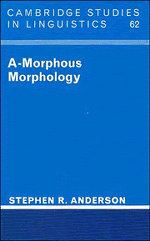Book contents
- Frontmatter
- Contents
- Acknowledgments
- Introduction
- 1 The study of word structure
- 2 Why have a morphology at all?
- 3 Is morphology really about morphemes?
- 4 The interaction of morphology and syntax
- 5 The theory of inflection
- 6 Some complex inflectional systems
- 7 Morphology in the lexicon: derivation
- 8 Clitics are phrasal affixes
- 9 The relation of morphology to phonology
- 10 How much structure do words have?
- 11 Composites: words with internal structure
- 12 Morphology and the typology of languages
- 13 Morphological change
- 14 Morphology as a computational problem
- References
- Index
12 - Morphology and the typology of languages
Published online by Cambridge University Press: 10 January 2011
- Frontmatter
- Contents
- Acknowledgments
- Introduction
- 1 The study of word structure
- 2 Why have a morphology at all?
- 3 Is morphology really about morphemes?
- 4 The interaction of morphology and syntax
- 5 The theory of inflection
- 6 Some complex inflectional systems
- 7 Morphology in the lexicon: derivation
- 8 Clitics are phrasal affixes
- 9 The relation of morphology to phonology
- 10 How much structure do words have?
- 11 Composites: words with internal structure
- 12 Morphology and the typology of languages
- 13 Morphological change
- 14 Morphology as a computational problem
- References
- Index
Summary
One might think that the morphological systems of natural languages are sufficiently complex to justify the study of morphology as an object of interest in its own right. There is, however, another motivation which has sometimes driven the investigation of this area of linguistic structure: the desire to classify languages into (some small number of) distinct ‘types.’ In fact, much of the terminology which we inherit from traditional grammar in the domain of word structure was originally devised in the service of such classification.
The present chapter is concerned with the nature of the enterprise of typological classification of languages on the basis of their systems of word structure. The basis for this discussion is the set of proposals made by Edward Sapir. In his little book Language (Sapir 1921), he presented one of the most detailed typological schemas ever proposed for the word structure of natural languages, basing his discussion primarily on non-Indo-European material. He also believed deeply in the importance of such an analysis. For example, much of his proposed classification of the languages of North and South America rested not on evidence of the traditional comparative sort, but rather on his perception of typological similarities among languages. While he certainly did not believe that such structural similarities were a sure guide to genetic relationship, he did feel that once the core features of a language's structural type had been identified, these were the properties that were most likely to remain (and to have remained) stable over time.
- Type
- Chapter
- Information
- A-Morphous Morphology , pp. 320 - 335Publisher: Cambridge University PressPrint publication year: 1992



